

Fire in the hole
 |
Generally speaking, unless it's pouring from the pipes on a twilight blast to low e.t., fire anywhere near a drag race car is not a good thing. It usually means that a connecting rod is no longer connected, that your pristine engine block has a window of which even Pella could be proud, and that the essential slippery but equally combustible refined crude has found its way onto those cherry-red headers. Voila! Race car flambé.
But there was a time -- back in those wacky, free-love late 1960s and early 1970s -- when not only was it desirable to surround your drag car with flames, but you did it on purpose. Yes, race fans, I'm talking about the black art of the fire burnout.
Two of the best-known practitioners of the fire burnout were drag racing legends "T.V. Tommy" Ivo and "Big Daddy" Don Garlits, both of whom have been credited – and have credited themselves – with inventing the self-immolation starting-line practice.
 |
Ivo admits to being a born pyromaniac. He got his first taste of fire on a cool winter night while building a trailer and deploying smudge pots – used by farmers to keep their crops from freezing – to keep warm.
"Contrary to rumors, it does get pretty cold in California from time to time in the winter," he said. "Well, cold to Californians anyway. We worked on the driveway in front of my house for these large projects, well into the night at times, and the neighbors loved me for it. The smudge pots really worked good; they were nice and warm. It kind of looks like a jet car sitting on its nose doing burner pops, doesn't it?
"Anyway, we would add the kerosene that we used for fuel through a small door on the pot at the bottom and add a match. Poof! Instant heat. When it started to run out of fuel, it would start boiling the kerosene that was left in the bottom, and when you heard that, you'd just flip the lid over the very top to put out the flame and add more fuel through the little door in the bottom to fill it back up. Simple, huh? NOT! One time I looked in through the little door and couldn't see too good because it had a mist way inside from the hot kerosene. So I blew in through the opening to clear it out of the way, and I guess there must have been some flame still left there because when I added oxygen to the mist via my breath blowing in there, it put a flame back out of the hole about three inches across and engulfed my head in fire. You know how hair rolls up in balls when fire hits it? Well, of course, I closed my eyes, and the top eyelashes welded themselves to my bottom eyelashes. The hairs in my nose got singed, and I could smell burning hair. Being blinded by my eyelids being held closed, I thought I was totally on fire. So I rolled around on the ground like they tell you to do, beating myself about the head and ears, yelling, 'Put me out, put me out.' But all the guys (free slave labor) that were helping me could see I was all right and just stood there and laughed at me. That’s half the reason they helped me. Whenever I’d have a problem, it was usually pretty spectacular and dramatic, to say the least."
That wasn't the last of Ivo's fiery antics. Far from it.
"I used to do the old blow-fire-out-in-the air-from-your-mouth act at parties all the time," he recalled. "I would take a mouthful of lighter fluid and hold a match at arm's length and blow the fluid across the match, making a huge ball of fire to the delight of my audience. One night I was really going to impress them and took a BIG mouthful of lighter fluid, but I ran out of air before I ran out of fluid in my mouth. You see, you couldn't just spit out the lighter fluid in one ball of liquid; it would put the match out and not light. Instead, you'd force it out through your lips like you were playing a trumpet. This made a finer mist that worked well. BUT -- and here comes that 'but' again -- it would let it run down your chin, and when I ran out of air, the flame backed up to my mouth and lit my whole head on fire … or at least it seemed that way. So I gave that up! You'd have thought I'd learned not to play with fire."
Again, far from it. Ivo soon became one of the most notorious and well-publicized pyros in the business, as we will see.

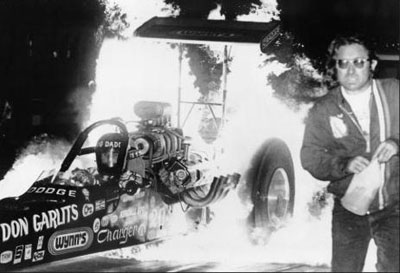 |
In his book Tales from the Drag Strip, Garlits relates that his first fire burnout was quite accidental.
"I was in Orlando [Fla.] one night, and we were doing our burnout with traction compound," he wrote. "Now the compound we were using – we called it glue -- was very volatile. RFI made it, and it was a thinner version of the glue that used to come with those old tire patch kits. It softened the rubber, and it really worked great. So I made my burnout and because there wasn't a lot of room around the starting line at this track, this was all pretty close to the starting line. When they backed me up, I rolled right back into the puddle of traction compound. It was getting pretty stringy by then and some of it got onto my exhaust pipes. The next thing you know my two tires are on fire! Now the guys on the crew jumped back and I gave it a little whap to get the tires to spin and get out of it. It was spectacular. The fire burnout was born."
Garlits went on to report that NHRA used to watch him and crewman T.C. Lemons to see if they were lighting off the compound with a match, which would have been cause for disqualification, but that was never the case as the fire burnouts were always the result of the same method accidentally employed in Orlando, and Lemons became the expert at knowing exactly how much glue to put under the tires for the desired effect.


Tommy Ivo (above) and Tony Nancy (below) showed off front-engine fire burnouts.
|
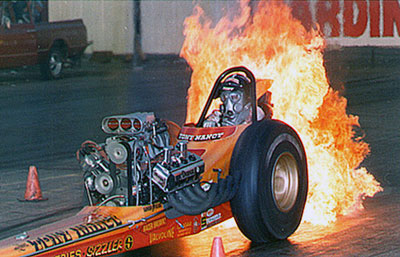 |
Garlits' version jibes with Ivo's and the generally understood birth of the fire burnout, though surely some have wondered about it after guys like "Flaming Frank" Pedregon either intentionally or accidentally occasionally produced a ring of fire around the circumference of their tires during runs when the spinning rubber caught fire.
You have to remember that back in the earlier '60s there wasn't even such a thing as a burnout, let alone a fire burnout, as Ivo recalls.
"The first time I ever heard of burnouts, Marvin [Rifchin] from M&H told me over the phone when I was getting some tires from him while I was on tour --gad, when wasn't I 'on tour'? -- and he told me to pour down some Clorox bleach in front of the tires and smoke the tires over the top of it and then back up in the tracks and it would really help the traction. The guys out on the West Coast were really having good results with it. Other than thinking he was crazy, I gave it a try."
Bleach was cheap and easy to find but kind of harsh, especially on team uniforms, and it wasn't long before companies like VHT developed traction compounds nor, as Garlits noted, long before racers discovered the compounds' other properties. Ivo, "the Master Showman," of course, had to take it a step further.
"It had some material in it that was flammable, and from time to time, it would give a flash fire when it would sling up just in the right way and catch fire from the fire in the headers. So I Ivo-ized it, meaning that when I saw possibilities in something, I’d make it bigger and better. We began adding extra gasoline to it, and the more gas we added, the better it got. To ensure that it would light, we’d use a match a lot of time to set it off, and when I saw the flame, I’d fan the clutch, and the tires would fling it into a huge ball of fire around the cockpit. It was like running your hand across a burning candle. As long as you kept moving, it was fine."
Although the promoters didn't pay up front for the fire show, they paid in the long run in the form of continued bookings.
"Since I was one of the first ones doing it, it was a complete surprise to everyone when I did it. It was just a new part of my act, as were the odd cars, glass trailers, and everything else I picked up as I went along," said Ivo. "[The track operators] would pass out a sort of report card at the tracks at the end of the year. They would give the customers a sheet of paper with the names of the people they had seen that year as well as the new guys that were up and coming in the various news media. The question was, 'Who would you like to see next year?' My name was always checked immediately. The folks just had to see what I was coming out with next year. I learned from my movie training that if you had the movie you were on in the bag, it would be very hard to fire you once they started the picture, but you were always working for the next picture (or booked-in race). It served me well in both industries."
Ivo did his first fire burnouts in a front-engine car, where it was easy to see what was going on, but though the transition to the rear-engine car removed the driver from the proximity of the flame, it also created its own issues with timing.
"The main difference was that with the front-engined car, there it was, right outside the cockpit, so to speak," he said. "I would, of course, keep a good eye on the guy with the gas in his hand. Then with the rear engine, I would just look over my shoulder to know when it was lit. One time, Tom McCourry was pouring down the gas from a jeep can full of gas for a handout picture in the Orange County shutoff area and we had a guy next to the cameraman, who was to drop his hand when it was lit with a match because I couldn't see it and I was distracted by the fact that I was in a rear-engine car for the first time," Ivo recalled. "I asked McCourry if he was afraid of fire because I would have someone else pour it down; he said, 'Hell no,' and dumped the whole five gallons of gas on the ground and lit it. It was so awesome! I looked at the signal guy, and he did nothing. He was so shocked, but I saw his jaw drop and figured out something was going on and dropped the clutch.
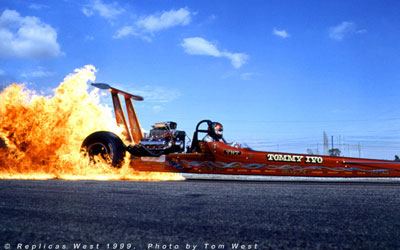 |
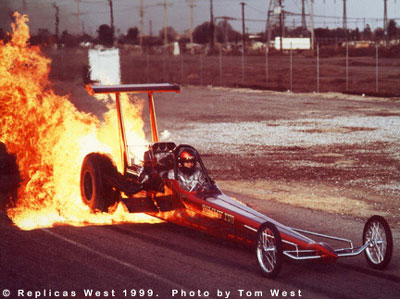 |
"The first one we did with the rear-engine car was the first time I let out the clutch on a rear-engine dragster and thought [photographer] Tom West was very brave to stand on a ladder six inches off to one side of the front wheel when even I didn’t know which way the car was going to go when I let out the clutch. In fact, I was worried I might cut the ladder out from under him and he would come crashing down on the car and end up in the cockpit with me. First rides in the rear-engine cars did tend to be exciting for old front-motor car drivers. In fact, I was so nervous about it I forgot to put my gloves on the first try."
West remembers it well. "The event that Ivo was talking about was on the return road at Lions. Steve Reyes and Bob McClurg made the most hay out of this deal, but I ended up with a shot from this first burnout that appeared in Drag Racing USA. You can clearly see Ivo's hands and that they were outside the roll cage; he wanted to be able to get out of the car quickly in case something happened.
"Of course, he might have said something to me about it. Said I showed so much confidence in him that he would rather kill me than admit he was not feeling the same. We went ahead with the burnout, which he carried under power past my spot. Almost blew me off the damned ladder with the header blast.
"The third, and the most spectacular of the burnouts -- five gallons of gas involved there -- was the one that got to me, as the wind had changed, something that I grew to respect when doing fire burnouts. Did a wide-angle, ground-level shot that almost set me on fire as the wind blew the fireball right over me. Steve almost fell off the ladder laughing as I stood up in my yellow Wynn's jacket with steam and scorched hair smoking, so I looked like a big torch, according to Reyes."
According to Garlits, all of this came to a nasty head one year in Indy when various teams were using traction compound and the bleach box was so full of liquid "you could have floated the Queen Mary," he said. Garlits spun 'em up and lit up the bleach box in both lanes. Although no one was injured in the fire, according to Garlits, NHRA banned the use of traction compounds at its national events, and the fire burnouts stopped (mostly).
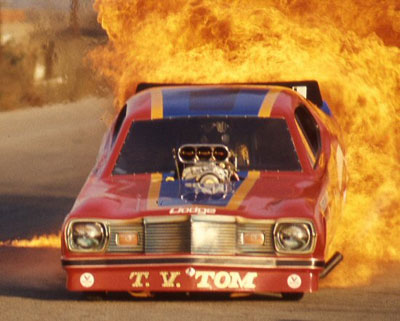 |
Not that the ban stopped the show at the booked-in matches, where fans thrilled to the fiery antics, nor did it stop showman Ivo from garnering magazine covers with the flame shows. One of Ivo's most spectacular fire burnouts was in his Dodge Charger Funny Car at Orange County Int'l Raceway,
"We used a five-gallon jeep can full of gas and did it in the shutoff area so we wouldn't mess up the track," he recalled. "You can see how big the fire was, and we didn't get the whole flame in [the picture]. It was about 15 feet in the air off to the right side of the picture."
Ivo would prep the car for such pyrotechnics by removing the parachutes and then coating the back side of the body with Vaseline to give momentary protection against singeing the paint.
After Ivo got out of Funny Car racing, he took to an easier way to sate his desire for fire: He drove a jet dragster.
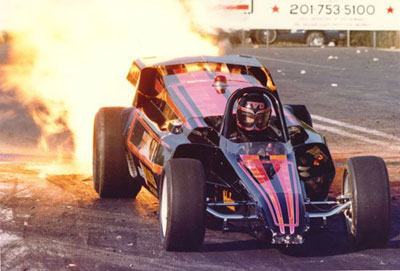 |
"I took to jet cars like a duck to water," he laughed. "It was a legal fire burnout with that big flame it put out on the starting line, although it would bother the track as well. When you were to close to the starting line and put the fire out the back, it would make a kind of powdercoat out of the track without really hurting it and would go away almost right away. [Don] Prudhomme came over to me in Sacramento one time and rapped my afterburner with a wrench like a tin car and asked me, 'Does this "thing" leak?' That pissed me off, and I gave the line a good cooking just before he ran, and he went every which way but straight! <evil grin>"
Although the fire burnout has largely gone the way of the dry hop, dollar-a-gallon gas, and drive-in movies, it still holds a special spot in the hearts of many drag race fans, and you can still occasionally see a good fire burnout or two from the odd exhibition car. Once you've seen, felt, or even been close enough to smell one, you don't soon forget it.

I've collected a ton of fire-burnout pics over the years. Here are a dozen or so of the best.
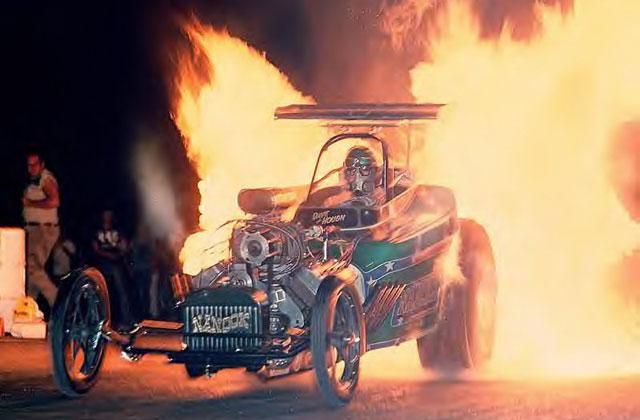
This is Dave Hough and the Nanook fuel altered.
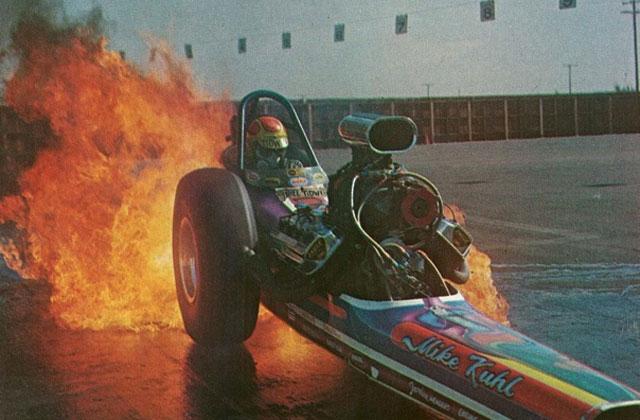
Billy Tidwell in Mike Kuhl's slingshot at OCIR
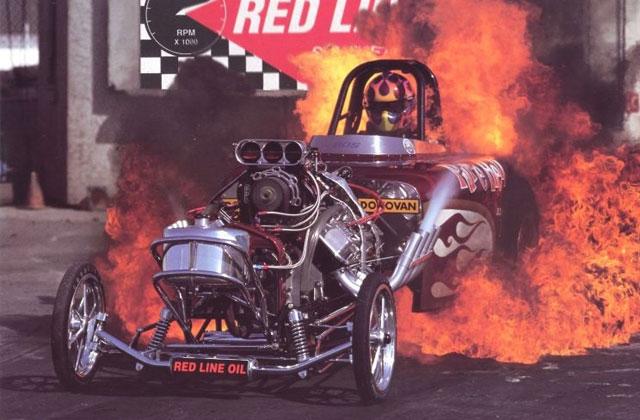
Living up to its name: the Pure Hell fuel altered
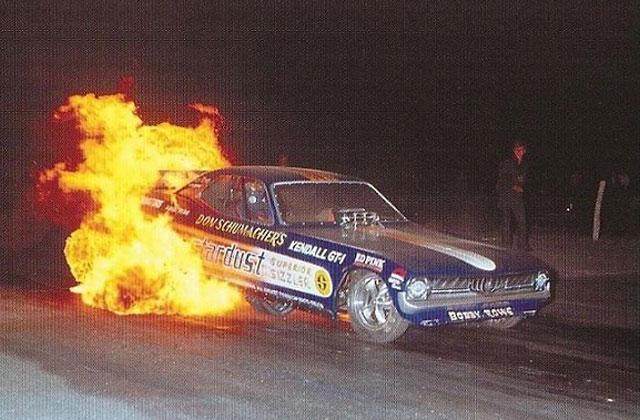
Funny Cars got into the act, too. Here's Don Schumacher lighting 'em up.
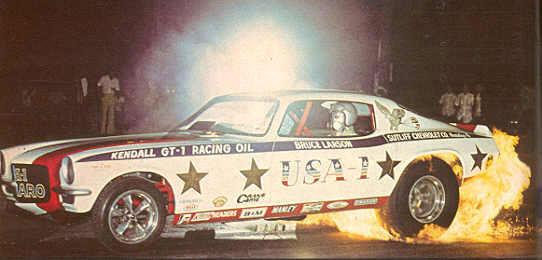
And Bruce Larson and his famed USA-1 Camaro
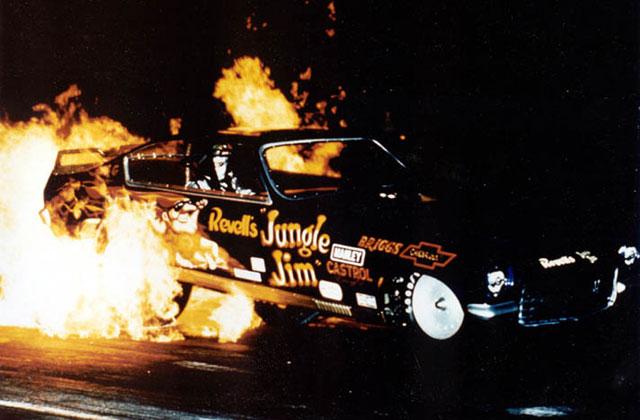
And, of course, the "Jungle" man. I believe this was on the Revell model box.
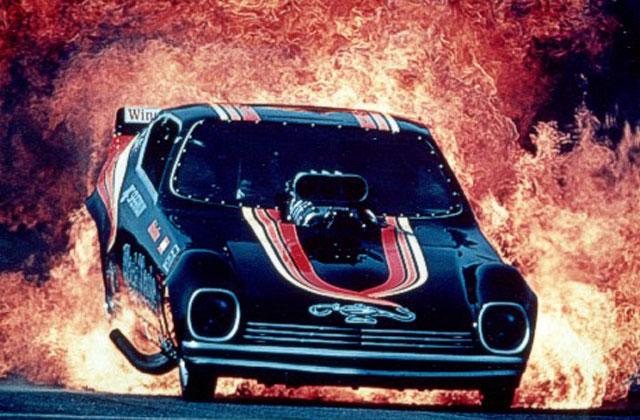
This is a pretty famous pic of Al Segrini and the Black Magic Vega, but something always looked fishy about this pic. Those are some pretty tall flames.
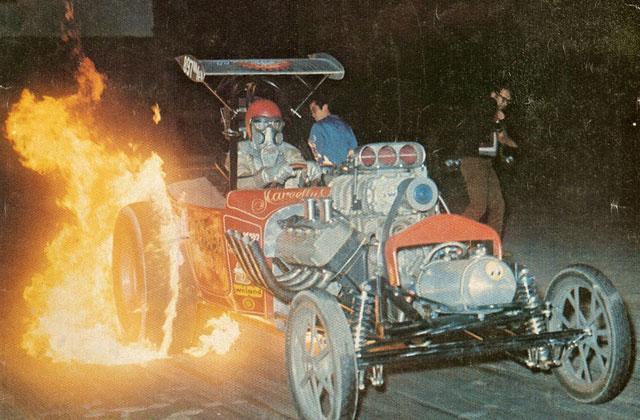
"Wild Willie" Borsch (pre-monster wing) showing how he got his name.
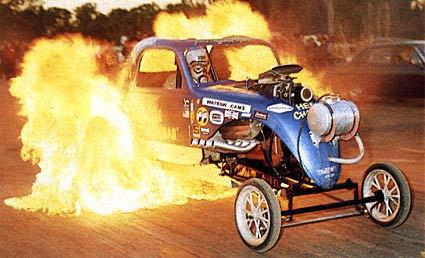
John Taylor's fiery Fiat
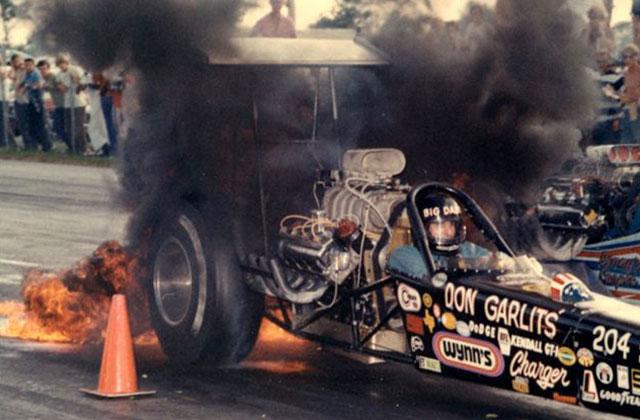
"Big Daddy" cooks the meats.
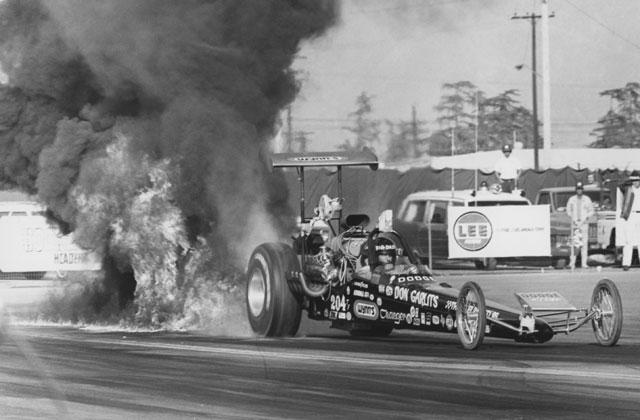
Garlits in Pomona during the Winternationals. The amount of black smoke would seem to indicate the presence of gasoline!
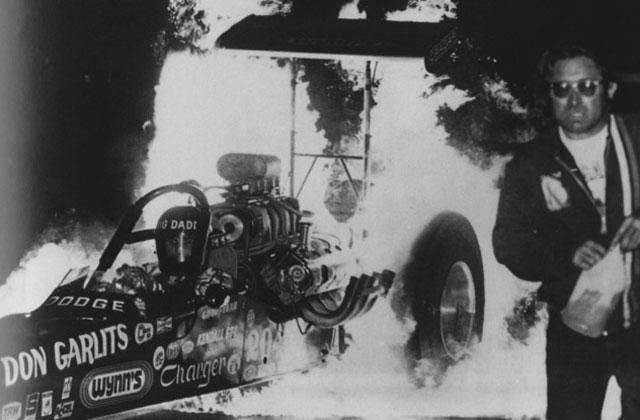
T.C. Lemons, drag racing arsonist
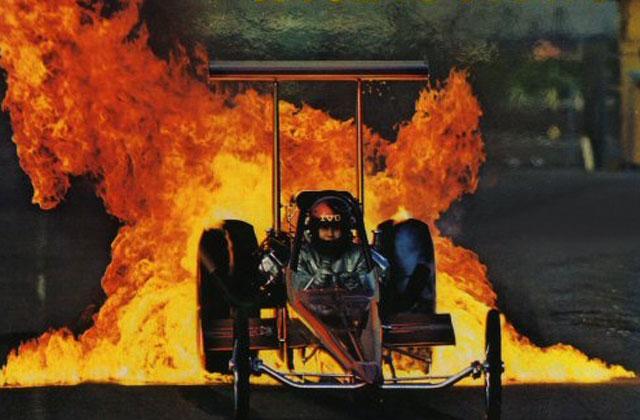
"T.V. Tom" doing his thang.
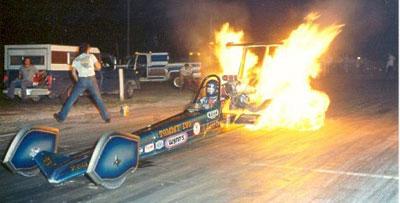
Hot pants!
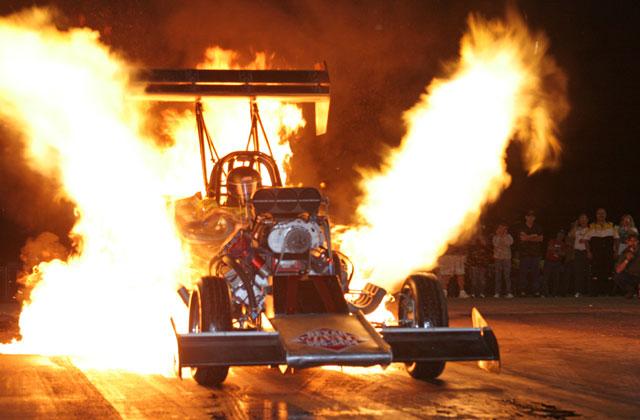
This is Top Fuel owner Mitch King and his modern-day fuel altered showing that the art of the fire burnout lives on.



















































